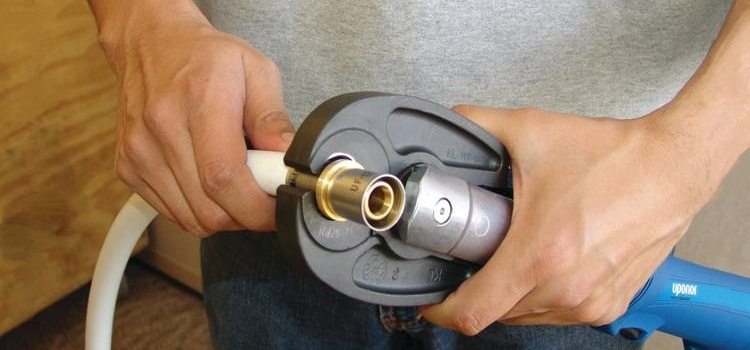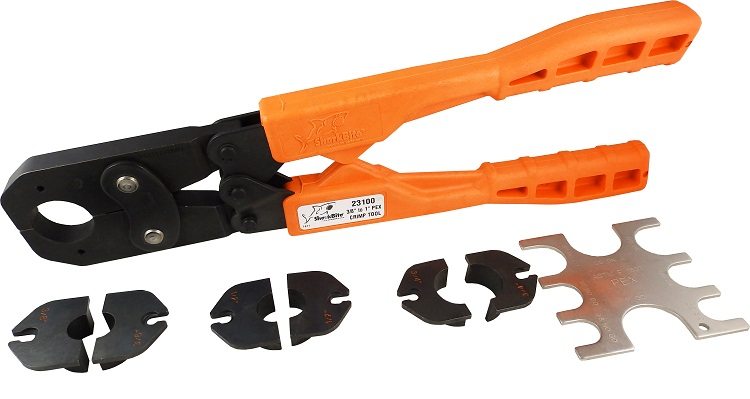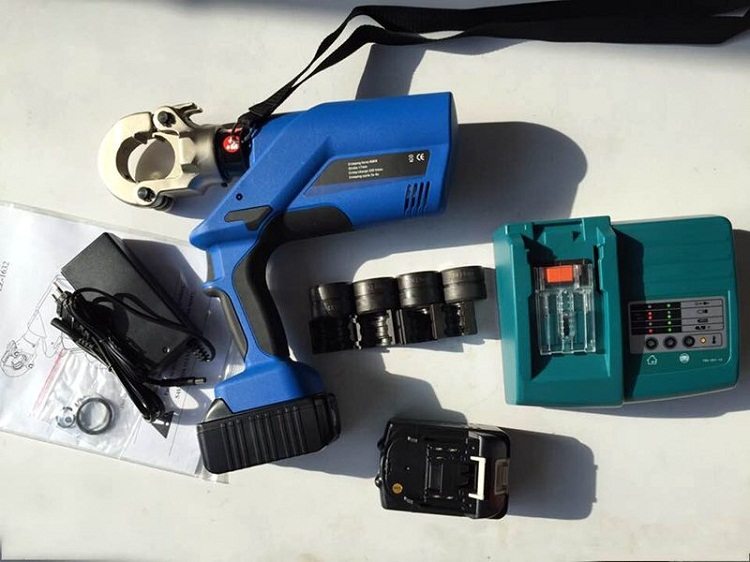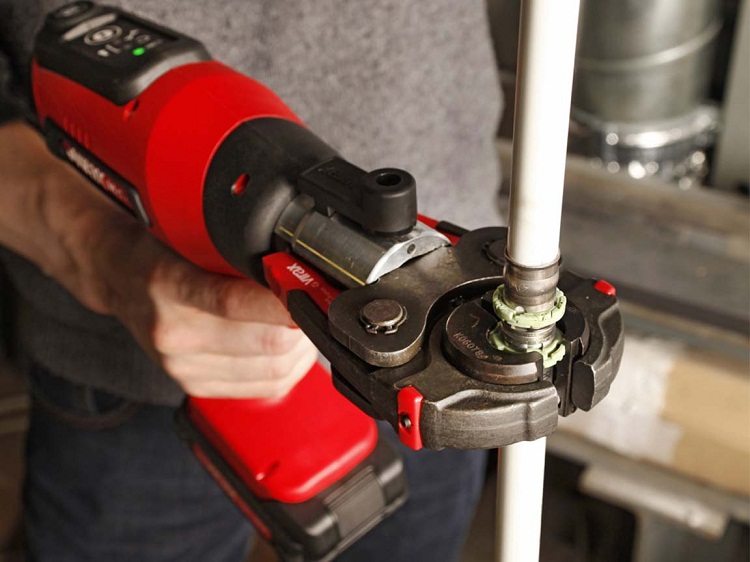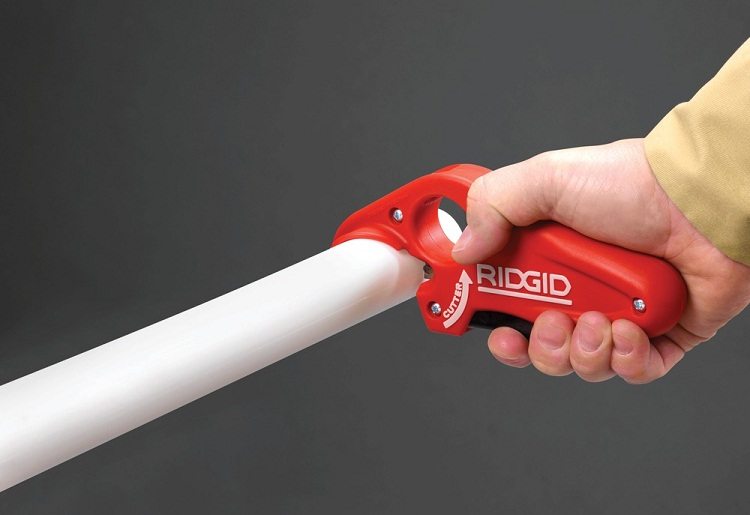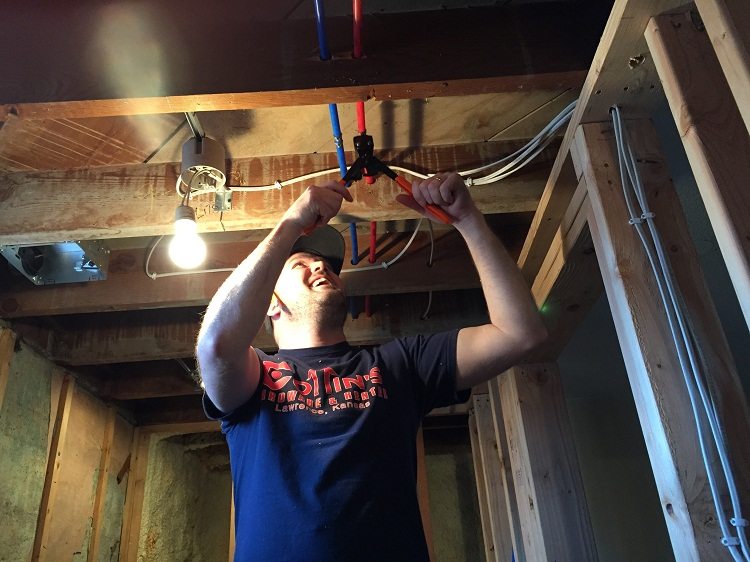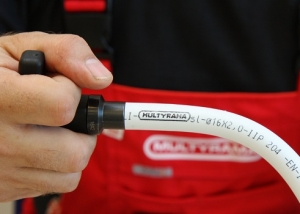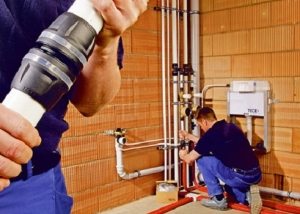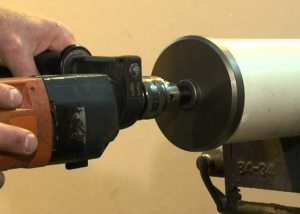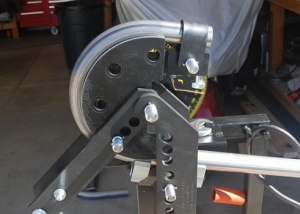When independently conducting any pipeline, except for the necessary materials, it is important to have a suitable installation tool. To connect steel pipes, you need a welding machine, copper - a special soldering iron, and for plastic pipes - press for crimping fittings. Thanks to the use of press fittings, you can get the most durable joint. This is true for concealed piping.
Content
Variety of products
The purpose of the press for crimping metal-plastic pipes can be divided into two categories:
- household;
- professional.
The first type is intended for use in the household, the second - for construction companies with significant amounts of work. Manual model presses belong to household crimping presses for metal-plastic pipes. They are easy to use and cost much cheaper than professional counterparts.
Note! Most models of manual press tongs for metal pipes equipped with a crimping head and a set of removable liners for different diameters of products.
Professional crimping equipment is:
- hydraulic;
- electromechanical;
- electric;
- electrohydraulic.
Such a press tool for metal-plastic pipes is driven by a hydraulic or electric drive, so it does not require the use of muscular force by the operator. This allows you to increase the speed and volume of work performed. The cost of the tool is much more expensive than manual, so buying it for domestic needs does not make sense.
Features of hand pipe press
Metal-plastic products can be crimped with mechanical and hydraulic manual pliers. The first type of tool consists of two handles that are connected to the crimp head using a gear mechanism. When they are compressed, the force is transferred to the head, and it, in turn, compresses the sleeve fitting.
Such pliers for metal pipes have the ability to adjust the length of the handles, which facilitates the work of the operator. A mechanical tool is cheaper and structurally simple, but requires physical effort.
Hydraulic press pliers for metal pipes on one of their handles have a hydraulic cylinder. Its output rod is mechanically connected to the crimp head. During the reduction of the handles, a piston is pressed into the hydraulic cylinder and pressure is created, which is transmitted to the head. Thus, less effort is expended during operation, but this increases the cost of the tool and requires regular maintenance.
Electrohydraulics tool
Electro-hydraulic models of pipe presses are characterized by small dimensions, weight, as well as high performance and ease of use. They are used for crimping products with a cross section of up to 110 millimeters.
By type of power, electro-hydraulic presses are:
- network
- rechargeable;
- universal.
Accumulator models work from the battery built in them, network - from the usual power supply network, universal are capable to function in both modes. Electro-hydraulic clamps use only universal removable press heads designed for a separate section of a metal-plastic pipe.
Note! The tool with a battery is designed to carry out approximately 50-100 crimps in one charge cycle.
Press pliers of this type allow you to evenly distribute the load over the entire surface of the joint and work more smoothly. This explains the high quality of the obtained compounds.
How to choose the right press pliers
When choosing press tongs for working with pipes made of metal-plastic, it is necessary to know their maximum diameter. These and other necessary technical data are recorded in the instrument passport. Press tongs are equipped with a set of liners, with which you can compress products with smaller sections.
When buying, it is important to pay attention to the presence of built-in optimization and control systems:
- OPS
- APS
- APC
OPS is a system of step clamps, due to which optimization and increase of applied efforts occur. In the presence of APS, the load on the sleeve during pressure testing will be distributed evenly. This advanced system facilitates the work, because the degree of effort is directly dependent on the size of the fitting. In the presence of APC, the crimping process will not be interrupted until the crimping of the sleeve is completely completed. Such a system controls the creation of a tight joint on its own.
Most manual press tongs are designed for crimping pipes with a cross section of up to 2.6 centimeters. Reinforced mechanical and hydraulic manual models allow you to work with products with a diameter of up to 3.2 cm.
The most expensive equipment is produced by manufacturers in Belgium, Germany, however, you can find quite functional and affordable press tongs Turkish or Italian production.
Actions before applying ticks
When connecting a fitting to a metal-plastic pipe by crimping, it is important to adhere to a certain sequence of actions. First, the required length is measured from the bay. To do this, you can use either a tape measure or marks on the outer surface of the product.
Note! When measuring, it is necessary to add some length to the lap.
The measured part is cut off plastic pipe scissors. It is important to achieve the most even cut, which is a right angle with the central axis of the product. If guillotine-type shears are used, then their lower edge must be held parallel to the pipe surface, slightly pressing into it.
Further, the ends of the metal-plastic pipe are calibrated with a special tool. The calibrators used can not only align the cut shape, but also remove the inner chamfer. Then, a crimp sleeve removed from the fitting is put on the pipe, and its fitting is inserted into the cut. The ends of the connecting elements are pressed tightly. The contact point of the ends should be insulated with a sealing gasket, which will protect the elements from electrocorrosion and ensure tightness.
The position of the pipe in the sleeve is controlled using a round neckline at its edge. The next stage uses press tongs.
Manual crimping
Press pliers for pipes made of metal-plastic are laid on a flat surface, spreading the handles 180º. The upper part of the cage is detached and the upper half of the press insert corresponding to the size of the pipe used is inserted. Its lower half is inserted into another part of the cage, and it clicks.Next, the assembled “pipe + fitting” assembly is placed in the tool. The fitting sleeve must be inside the press liner. In addition, it is unacceptable to deform the fitting with press tongs with nozzles of inappropriate diameters. Even a 5 mm offset is critical to the build quality of the pipeline.
After that, the tick handles move together until they stop. When crimping, 2 identical arched strips of metal should form. The result is a securely fastened fitting that is almost impossible to remove with working tools. The work is done incorrectly if:
- the nut is loose;
- between the nut and the plastic pipe, an opening of more than 1 mm is visible;
- the nut is not fully tightened, etc.
The maximum pressure withstanding pipe joints is 10 bar.
The nuances of using the tool
Specialists identify several places where it is extremely inconvenient to work with press pliers - ducts, shtrobs, under false floors, and false ceilings. In such cases, it is recommended to use a press gun.
Using this type of crimping tool allows you to rotate it around the axis of the pipe junction, to prevent injuries, and also control the press with one hand.
Note! Compression of the fitting with press tongs should be single. Repeated exposure is unacceptable.
Not always buying equipment for single use at home is economically feasible. If it is necessary to crimp the metal-plastic pipeline, you can rent a press or contact a specialized organization for such work.
Also, to obtain a high-quality connection, it is important to carefully clean the ends of the metal-plastic pipes. Although there is no thread inside the fitting, it is better to perform several rotational movements when installing it. When working with manual pincers, sharp deformations must be avoided.
The use of press tongs for crimping a metal-plastic pipe is an important step installation of a water supply system. Manufacturers offer a wide variety of models for this. A high-quality crimp will guarantee the durability and efficiency of the pipeline.
